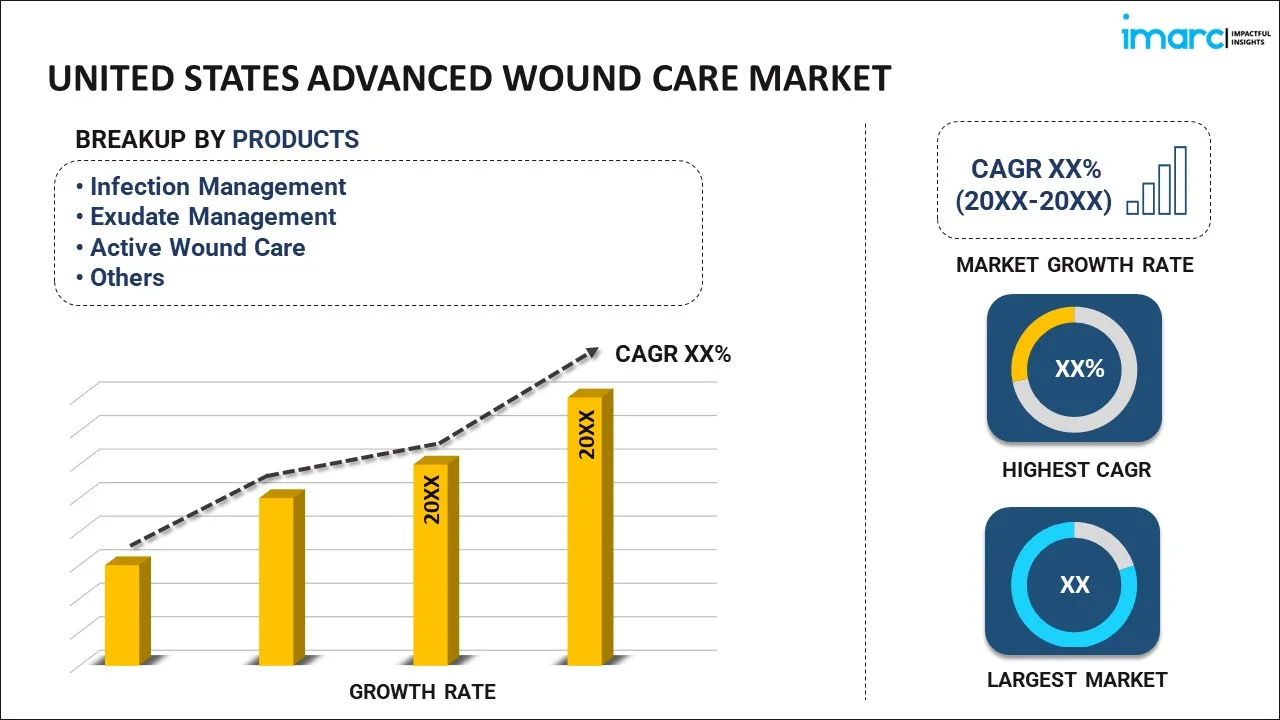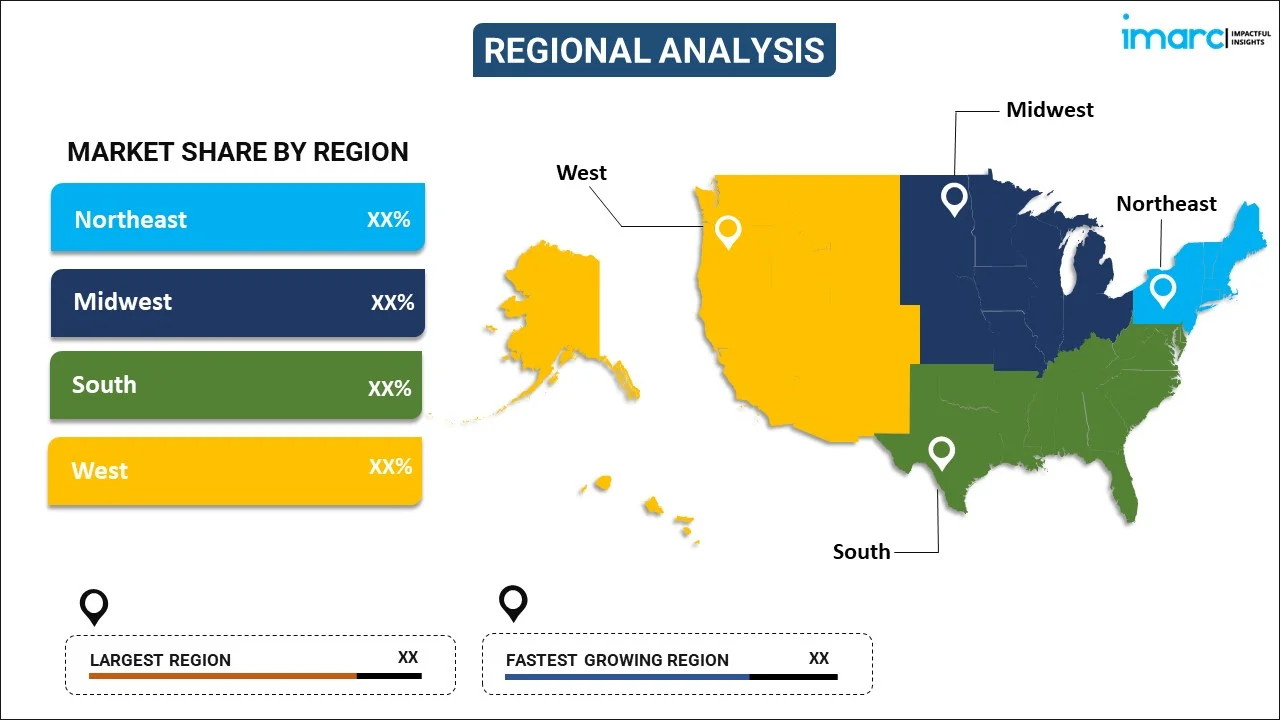
United States Advanced Wound Care Market Report by Product (Infection Management, Exudate Management, Active Wound Care, Therapy Devices, and Others), Application (Chronic Wounds, Acute Wounds), End User (Hospitals, Community Health Service Centers), and Region 2025-2033
Market Overview:
The United States advanced wound care market size reached USD 2.7 Billion in 2024. Looking forward, IMARC Group expects the market to reach USD 4.4 Billion by 2033, exhibiting a growth rate (CAGR) of 5.3% during 2025-2033. The growing prevalence of chronic diseases, such as diabetes and obesity, rising occurrence of pressure ulcers and venous leg ulcers, and increasing awareness among the masses about the importance of timely wound management represent some of the key factors driving the market.
|
Report Attribute
|
Key Statistics
|
|---|---|
|
Base Year
|
2024
|
|
Forecast Years
|
2025-2033
|
|
Historical Years
|
2019-2024
|
|
Market Size in 2024
|
USD 2.7 Billion |
|
Market Forecast in 2033
|
USD 4.4 Billion |
| Market Growth Rate 2025-2033 | 5.3% |
Advanced wound care refers to a specialized approach of treating complex and chronic wounds, going beyond traditional methods to promote optimal healing and recovery. It comprises the usage of specialized dressings, negative pressure wound therapy, and growth factor applications, aimed at creating an optimal environment for healing. It relies on cutting-edge technologies like hyperbaric oxygen therapy and bioengineered skin substitutes, wherein hyperbaric oxygen therapy involves exposing wounds to elevated oxygen levels, promoting tissue repair and bioengineered skin substitutes provide a scaffold for cells to regenerate, fostering faster healing while reducing scarring. Advanced wound care integrates evidence-based techniques and innovative technologies to accelerate the healing process and minimize complications. It offers personalized treatment plans that help healthcare professionals assess the characteristics and underlying causes of the wound to devise tailored interventions. It also provides advanced infection prevention as chronic wounds are susceptible to infections. Medical practitioners follow stringent hygiene practices, administer appropriate antibiotics when necessary, and employ strategies to manage biofilm, a common barrier to healing. As advanced wound care delivers enhanced healing rates, reduced hospital stays, and improved quality of life to individuals, its demand is rising in the United States.
United States Advanced Wound Care Market Trends:
At present, the increasing prevalence of chronic diseases, such as diabetes and obesity, represents one of the key factors supporting the growth of the market in the United States. These conditions often lead to complex and slow-healing wounds, thereby driving the need for advanced wound care products and therapies. Besides this, the aging population in the country is leading to the occurrence of age-related wounds, such as pressure ulcers and venous leg ulcers, which is catalyzing the demand for advanced wound care solutions. In addition, rapid advancements in medical technology are directing the development of innovative wound care products. Advanced dressings, negative pressure wound therapy systems, and bioactive wound care materials are revolutionizing wound treatment approaches, attracting both patients and healthcare providers in the United States. Moreover, the shift towards outpatient care settings is propelling the demand for wound care solutions that enable efficient healing outside of traditional hospital environments. In line with this, advanced wound care products that facilitate self-care and reduce hospital stays are offering lucrative growth opportunities to industries in the United States. Apart from this, the growing awareness among the masses and healthcare professionals about the importance of timely and effective wound management is positively influencing the market in the country.
United States Advanced Wound Care Market Segmentation:
IMARC Group provides an analysis of the key trends in each segment of the United States advanced wound care market report, along with forecasts at the country level for 2025-2033. Our report has categorized the market based on product, application, and end user.
Product Insights:

- Infection Management
- Silver Wound Dressings
- Non-silver Dressings
- Collagen Dressings
- Exudate Management
- Hydrocolloids Dressings
- Foam Dressings
- Alginate Dressings
- Hydrogel Dressings
- Active Wound Care
- Skin Substitutes
- Growth Factors
- Therapy Devices
- Negative Pressure Wound Therapy (NPWT)
- Oxygen and Hyperbaric Oxygen Equipment
- Electromagnetic Therapy Devices
- Others
The report has provided a detailed breakup and analysis of the market based on the product. This includes infection management [silver wound dressings, non-silver wound dressings, and collagen dressings]; exudate management [hydrocolloids dressings, foam dressings, alginate dressings, and hydrogel dressings]; active wound care [skin substitutes and growth factors], and therapy devices [negative pressure wound therapy (NPWT), oxygen and hyperbaric oxygen equipment, and electromagnetic therapy devices] and others.
Application Insights:
- Chronic Wounds
- Pressure Ulcers
- Diabetic Foot Ulcers
- Venous Leg Ulcers
- Arterial Ulcers
- Acute Wounds
- Burns and Trauma
- Surgical Wounds
A detailed breakup and analysis of the market based on the application has also been provided in the report. This includes chronic wounds (pressure ulcers, diabetic foot ulcers, venous leg ulcers, and arterial ulcers) and acute wounds (burns and trauma and surgical wounds).
End User Insights:
- Hospitals
- Community Health Service Centers
A detailed breakup and analysis of the market based on the end user has also been provided in the report. This includes hospitals and community health service centers.
Regional Insights:

- Northeast
- Midwest
- South
- West
The report has also provided a comprehensive analysis of all the major regional markets, which include Northeast, Midwest, South, and West.
Competitive Landscape:
The report has also provided a comprehensive analysis of the competitive landscape in the United States advanced wound care market. Competitive analysis such as market structure, key player positioning, top winning strategies, competitive dashboard, and company evaluation quadrant has been covered in the report. Also, detailed profiles of all major companies have been provided.
United States Advanced Wound Care Market Report Coverage:
| Report Features | Details |
|---|---|
| Base Year of the Analysis | 2024 |
| Historical Period | 2019-2024 |
| Forecast Period | 2025-2033 |
| Units | Billion USD |
| Scope of the Report | Exploration of Historical and Forecast Trends, Industry Catalysts and Challenges, Segment-Wise Historical and Predictive Market Assessment:
|
| Products Covered |
|
| Applications Covered |
|
| End Users Covered | Hospitals, Community Health Service Centers |
| Regions Covered | Northeast, Midwest, South, and West |
| Customization Scope | 10% Free Customization |
| Post-Sale Analyst Support | 10-12 Weeks |
| Delivery Format | PDF and Excel through Email (We can also provide the editable version of the report in PPT/Word format on special request) |
Key Questions Answered in This Report:
- How has the United States advanced wound care market performed so far and how will it perform in the coming years?
- What has been the impact of COVID-19 on the United States advanced wound care market?
- What is the breakup of the United States advanced wound care market on the basis of product?
- What is the breakup of the United States advanced wound care market on the basis of applications?
- What is the breakup of the United States advanced wound care market on the basis of end users?
- What are the various stages in the value chain of the United States advanced wound care market?
- What are the key driving factors and challenges in the United States advanced wound care market?
- What is the structure of the United States advanced wound care market and who are the key players?
- What is the degree of competition in the United States advanced wound care market?
Key Benefits for Stakeholders:
- IMARC’s report offers a comprehensive quantitative analysis of various market segments, historical and current market trends, market forecasts, and dynamics of the United States advanced wound care market from 2019-2033.
- The research study provides the latest information on the market drivers, challenges, and opportunities in the United States advanced wound care market.
- Porter's five forces analysis assist stakeholders in assessing the impact of new entrants, competitive rivalry, supplier power, buyer power, and the threat of substitution. It helps stakeholders to analyze the level of competition within the United States advanced wound care industry and its attractiveness.
- Competitive landscape allows stakeholders to understand their competitive environment and provides an insight into the current positions of key players in the market.
Need more help?
- Speak to our experienced analysts for insights on the current market scenarios.
- Include additional segments and countries to customize the report as per your requirement.
- Gain an unparalleled competitive advantage in your domain by understanding how to utilize the report and positively impacting your operations and revenue.
- For further assistance, please connect with our analysts.
 Inquire Before Buying
Inquire Before Buying
 Speak to an Analyst
Speak to an Analyst
 Request Brochure
Request Brochure
 Request Customization
Request Customization




.webp)




.webp)












